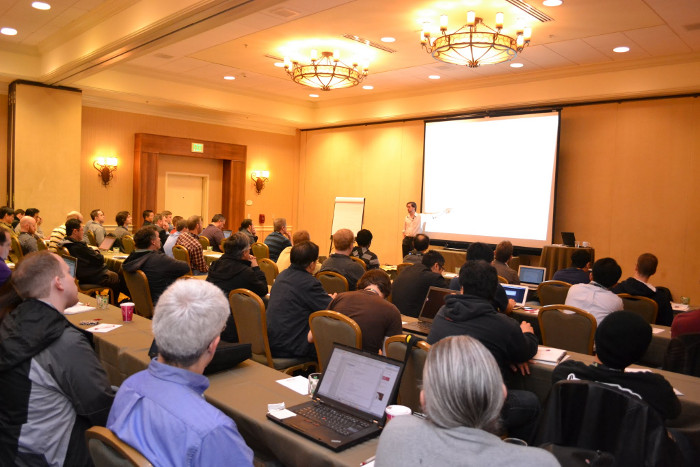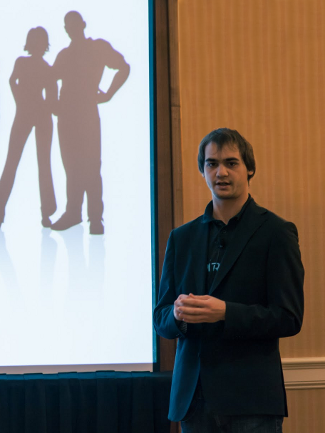KDE at Qt Developer Days 2012 Silicon Valley
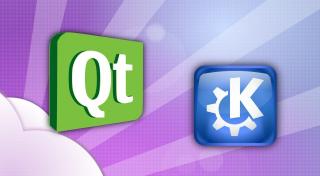
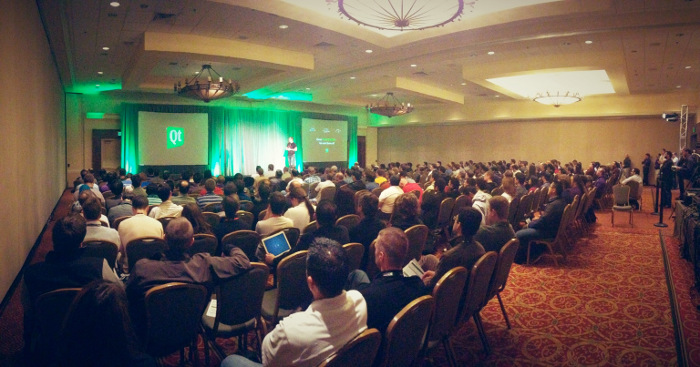
Keynote at Qt Dev Days 2012 Silicon Valley (photo by ICS)
Background
Since KDE’s start in 1996, Qt technology has been a key element of KDE. In turn, KDE has also had considerable influence on Qt in that time. In 2011, several major developments occurred within the Qt environment—in March, Nokia sold some Qt commercial licensing rights to Digia, and in October, the open Qt Project became the main development force behind Qt. (KDE has substantial influence within the Qt Project.) In August 2012, Digia bought the remaining Qt software business from Nokia. These events created significant changes in the Qt environment, as well as opportunities that are not yet fully realized. KDE is well positioned to have a leadership role in the future of Qt.Qt Developer Days 2012 Silicon Valley was an opportunity to show the strong relationship between Qt and KDE, the interrelated structures of Qt 5 and KDE Frameworks 5, and the substantial value that KDE brings to the Qt ecosystem.
KDE e.V. member Dario Freddi started the idea of KDE participating in a big way in QtDevDays in California. Dario, Claudia Rauch and a small team put together KDE activities at the Conference, recruiting KDE speakers and attendees as well as open source supporters from throughout the Silicon Valley area. There were other activities as well, including a KDE exhibit and KDE Birds of a Feather session. Special thanks to Google for sponsoring the BoF session.
KDE and friends in the Expo
Martin Klapetek, David Edmundson, Martin Gräßlin, Arthur Arlt and I shared staffing responsibilities at the KDE exhibit. As might be expected, there were many other people at the conference with KDE ties who helped promote the KDE presence and answered questions at the KDE booth. Frederik Gladhorn was at the conference with Digia and showed off accessibility magic at the KDE exhibit space. Aaron Seigo showed up from time to time to talk about Plasma Active and Workspace architecture ... when he wasn't busy with Vivaldi open tablet strategy discussions and several presentations.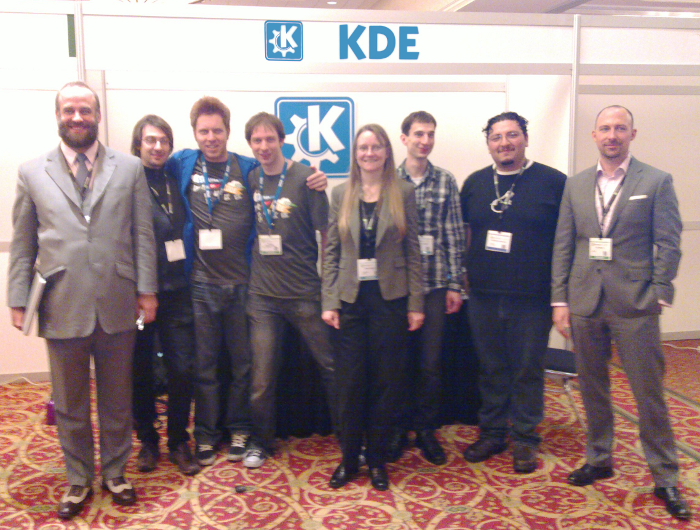
left to right - Matthias Kalle Dalheimer, Arthur Arlt, Martin Klapetek, David Edmundson, Alex Spehr, Martin Gräßlin, Guillermo Antonio Amaral Bastidas, Till Adam (photo by Alex Spehr)
In addition to the KDE exhibit space, there were plenty of other KDE e.V. members and supporters taking part in the conference, with KDAB and Digia having significant roles in producing and sponsoring the Conference. The KDAB exhibit was just opposite the KDE space, so we saw a lot of Guillermo Antonio Amaral Bastidas, Till Adam, Jesper Pedersen and Matthias Kalle Dalheimer. Harri Porten and Alex Spehr were at the Froglogic exhibit. Blue Systems, ICS and Ispirata covered travel expenses for several of the KDE people.
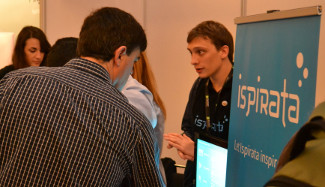
Riccardo & Ispirata (photo by ICS)
KDE presentations and influence
About 1/3 of the presentations were given by people with strong ties to KDE. The sessions dealing with How To Qt were overflowing, especially those presented by people who are speaking from experience...such as KDE contributors. It is clear that KDE is a major force in the Qt ecosystem. As Frameworks 5 becomes more of a reality, KDE’s value and influence will grow substantially.Visitors to the KDE exhibit space commented about how they can use what the KDE Community has developed. They were encouraged to join KDE projects for the obvious benefits they would receive and for the value of contributing to and serving others. Martin Klapetek and David Edmundson presented Why Be A KDE Project? based on the benefits and principles associated with the KDE Manifesto. At the booth, there was a biz card brochure with the Manifesto on one side and a QR code for various KDE websites and other resources on the reverse.
There were about 15 people at the KDE BoF, including KDE contributors and others interested in what KDE is doing. After a short meeting at the conference venue, we walked as a group to a nearby pizza place. During the walk, the wait for a meeting space, and pizza & beer, there were lively conversations about KDE, Qt, KDE stories, jokes and areas of common interest. It was like a mini-Akademy, except no one was hacking.
My presentation about the Mer Project emphasized its value for device development and describing its open source, open governance and open development. The presentation explored the background of the close relationship that has developed between the Mer Project and Plasma Active.
There was a panel on the future of open tablets that included Jono Bacon from Canonical, Aaron Seigo, David Greaves (the Mer Project) and Vesku Hartikainen (Jolla). I moderated this discussion that ranged beyond open tablets to the importance of communication, the value of open development, Qt as a development environment. There was even the timeless question—“The technology is free, so how does anyone make money?”
Preparing for my other presentation What KDE Offers gave me the opportunity to learn a lot. It really made clear the value that KDE provides, especially in the Qt world. During the presentation, there were several KDE contributors in the audience, all of whom have participated in Google Summer of Code. I presented an abridged version of several Frameworks 5 presentations (thanks to David Faure, Aaron Seigo and Kévin Ottens, as well as all the contributors to the Community Wiki dealing with Frameworks 5). The presentation ended with a quote from Aaron … “KDE is a smokin’ deal for any Qt developer.” I appreciate all the work that people have done to make it so easy to be a KDE enthusiast. I’ve been involved in many tech projects; none of them were as inspiring as KDE.